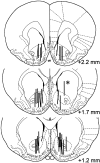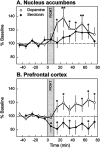Aggressive behavior, increased accumbal dopamine, and decreased cortical serotonin in rats
- PMID: 11125011
- PMCID: PMC6773005
- DOI: 10.1523/JNEUROSCI.20-24-09320.2000
Aggressive behavior, increased accumbal dopamine, and decreased cortical serotonin in rats
Abstract
Dopamine (DA) and serotonin have been implicated in the regulation of aggressive behavior, but it has remained challenging to assess the dynamic changes in these neurotransmitters while aggressive behavior is in progress. The objective of this study was to learn about ongoing monoamine activity in corticolimbic areas during aggressive confrontations in rats. Male Long-Evans rats were implanted with a microdialysis probe aimed at the nucleus accumbens (NAC) or medial prefrontal cortex (PFC); next, 10 min samples were collected before, during, and after a 10 min confrontation. Rats continued to display aggressive behavior while being sampled, and they performed two to six attack bites as well as 140 sec of aggressive acts and postures. Dopamine levels in NAC were significantly increased up to 60 min after the confrontation. Peak levels of 140% were achieved approximately 20-30 min after the confrontation. No concurrent changes in accumbal serotonin levels were seen during or after the confrontation. Dopamine and serotonin levels in PFC changed in the opposite direction, with a sustained decrease in serotonin to 80% of baseline levels during and after the confrontation and an increase in dopamine to 120% after the confrontation. The temporal pattern of monoamine changes, which followed rather than preceded the confrontation, points to a significant role of accumbal and cortical DA and 5-hydroxytryptamine in the consequences as opposed to the triggering of aggressive acts. The increase in accumbal DA in aggressive animals supports the hypothesis that this neural system is linked to the execution of biologically salient and demanding behavior.
Figures



References
-
- Abercrombie ED, Keefe KA, DiFrischia DS, Zigmond MJ. Differential effect of stress on in vivo dopamine release in striatum, nucleus accumbens, and medial frontal cortex. J Neurochem. 1989;52:1655–1658. - PubMed
-
- Adell A, Casanovas JM, Artigas F. Comparative study in the rat of the actions of different types of stress on the release of 5-HT in raphe nuclei and forebrain areas. Neuropharmacology. 1997;36:735–741. - PubMed
-
- Brown GL, Ebert MH, Goyer PF, Jimerson DC, Klein WJ, Bunney WE, Goodwin FK. Aggression, suicide, and serotonin-relationships to CSF amine metabolites. Am J Psychiatry. 1982;139:741–746. - PubMed
-
- Coccaro EF. Impulsive aggression and central serotonergic system function in humans: an example of a dimensional brain-behavior relationship. Int Clin Psychopharmacol. 1992;7:3–12. - PubMed
-
- Damsma G, Wenkstern D, Pfaus JG, Phillips AG, Fibiger HC. Sexual behavior increases dopamine transmission in the nucleus accumbens and striatum of male rats: comparison with novelty and locomotion. Behav Neurosci. 1992;106:181–191. - PubMed
Publication types
MeSH terms
Substances
Grants and funding
LinkOut - more resources
Full Text Sources
Miscellaneous
